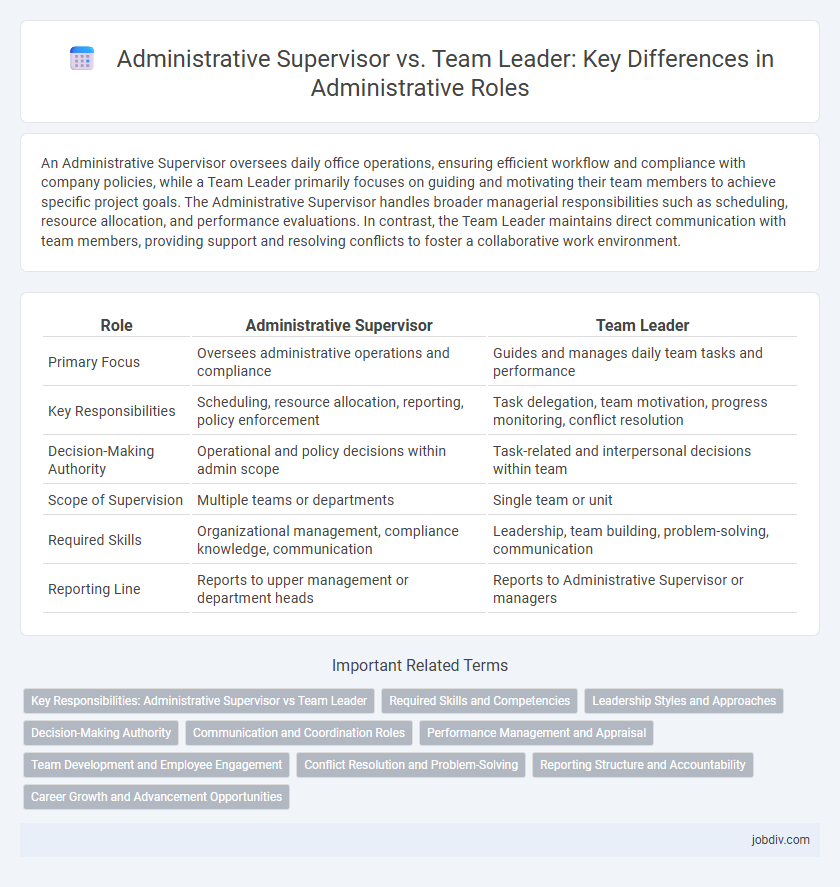An Administrative Supervisor oversees daily office operations, ensuring efficient workflow and compliance with company policies, while a Team Leader primarily focuses on guiding and motivating their team members to achieve specific project goals. The Administrative Supervisor handles broader managerial responsibilities such as scheduling, resource allocation, and performance evaluations. In contrast, the Team Leader maintains direct communication with team members, providing support and resolving conflicts to foster a collaborative work environment.
Table of Comparison
| Role | Administrative Supervisor | Team Leader |
|---|---|---|
| Primary Focus | Oversees administrative operations and compliance | Guides and manages daily team tasks and performance |
| Key Responsibilities | Scheduling, resource allocation, reporting, policy enforcement | Task delegation, team motivation, progress monitoring, conflict resolution |
| Decision-Making Authority | Operational and policy decisions within admin scope | Task-related and interpersonal decisions within team |
| Scope of Supervision | Multiple teams or departments | Single team or unit |
| Required Skills | Organizational management, compliance knowledge, communication | Leadership, team building, problem-solving, communication |
| Reporting Line | Reports to upper management or department heads | Reports to Administrative Supervisor or managers |
Key Responsibilities: Administrative Supervisor vs Team Leader
An Administrative Supervisor oversees office operations, ensures compliance with company policies, manages administrative staff, and coordinates workflows to optimize efficiency. A Team Leader focuses on guiding team members toward achieving project goals, providing performance feedback, and fostering collaboration within the team. Both roles require strong leadership skills, but the Administrative Supervisor emphasizes organizational management while the Team Leader concentrates on direct team coordination and motivation.
Required Skills and Competencies
An Administrative Supervisor requires strong organizational skills, proficiency in project management, and the ability to oversee administrative processes while ensuring compliance with company policies. A Team Leader must demonstrate excellent communication, leadership, and motivational abilities to manage team dynamics and drive performance effectively. Both roles demand problem-solving aptitude and adaptability, but the Administrative Supervisor focuses more on operational control, whereas the Team Leader emphasizes people management and conflict resolution.
Leadership Styles and Approaches
Administrative Supervisors often employ a transactional leadership style focused on task completion and adherence to organizational policies, ensuring efficiency and accountability. Team Leaders typically adopt a transformational leadership approach, inspiring and motivating team members to achieve collective goals through collaboration and innovation. Both roles require strong communication skills, but Administrative Supervisors emphasize structure and control, while Team Leaders prioritize empowerment and team development.
Decision-Making Authority
An Administrative Supervisor holds broader decision-making authority, overseeing policy implementation, resource allocation, and conflict resolution within multiple teams. A Team Leader primarily manages day-to-day operations, directing team members and making tactical decisions to achieve immediate goals. The supervisor's role involves strategic choices impacting the organization, while the team leader focuses on operational execution.
Communication and Coordination Roles
An Administrative Supervisor oversees communication workflows across departments, ensuring effective information exchange and alignment with organizational goals. They coordinate complex schedules, manage cross-functional tasks, and facilitate strategic meetings to maintain operational efficiency. In contrast, a Team Leader primarily directs daily team interactions, providing clear instructions and fostering collaboration to achieve immediate project objectives.
Performance Management and Appraisal
An Administrative Supervisor typically oversees performance management by setting clear objectives, monitoring progress, and ensuring appraisal processes align with organizational standards for optimal efficiency. In contrast, a Team Leader focuses on providing direct feedback and coaching to improve individual and team performance, fostering motivation through personalized appraisal discussions. Both roles are crucial for balancing operational efficiency with employee development in a structured administrative environment.
Team Development and Employee Engagement
Administrative Supervisors focus on overseeing operational processes to ensure compliance and efficiency, while Team Leaders prioritize team development and employee engagement by fostering collaboration and motivation. Effective Team Leaders implement targeted training programs and facilitate open communication to boost morale and productivity. Strong employee engagement under Team Leaders correlates with higher retention rates and improved team performance in administrative settings.
Conflict Resolution and Problem-Solving
Administrative Supervisors typically handle conflict resolution by implementing organizational policies and mediating disputes with a focus on maintaining structural consistency, whereas Team Leaders often resolve conflicts through direct communication and collaborative problem-solving within their teams. Supervisors assess issues from a broader administrative perspective to ensure compliance, while Team Leaders prioritize immediate resolution and fostering a positive team environment. Both roles require strong interpersonal skills, but the Supervisor's approach is more policy-driven, contrasting with the Team Leader's hands-on, day-to-day management style.
Reporting Structure and Accountability
An Administrative Supervisor typically oversees multiple teams and ensures that reporting lines are clearly defined, facilitating effective communication between frontline employees and upper management. The Team Leader directly manages individual team members, focusing on day-to-day operations and immediate task accountability. Reporting structures under an Administrative Supervisor tend to be more hierarchical, with broader oversight responsibilities compared to the more hands-on, task-specific accountability of a Team Leader.
Career Growth and Advancement Opportunities
An Administrative Supervisor typically oversees multiple teams and manages higher-level administrative functions, providing broader scope for leadership development and strategic decision-making skills. In contrast, a Team Leader focuses on direct team management and day-to-day operations, offering foundational experience in personnel coordination and task delegation. Career growth as an Administrative Supervisor often leads to senior management roles, while Team Leaders may advance by gaining operational expertise before moving into supervisory positions.
Administrative Supervisor vs Team Leader Infographic

 jobdiv.com
jobdiv.com